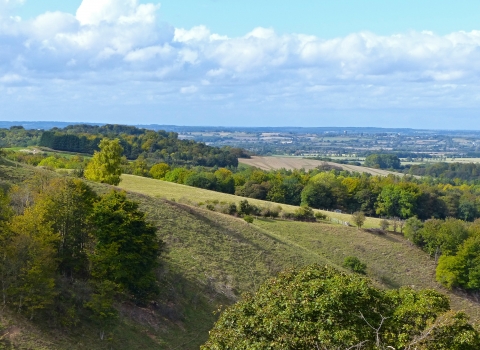The Wildlife Trusts believe it is vitally important to create a network of wild places for nature's recovery. This means not only improving our own sites for wildlife but helping others too. In the North Chilterns we've been helping improve a number of sites around Luton.
Galley and Warden fence repairs
During the summer our volunteer group spent a total of 124 person-hours repairing fences around Galley and Warden Hills. With over 4 miles of fencing and approximately 2,500 fences posts on the site, it's not surprising that it is an ongoing job for us to ensure that fences where the livestock are grazing are kept in good order.
Tree popping students at Warden Hill
Early in November we were delighted to be joined by a dozen students from Cranfield University on one of our regular Saturday Conservation Volunteer Tasks. The students, hailing from across the globe, really got stuck in to the job of clearing a dense patch of young hawthorn scrub that had begun to smother one of the flowery slopes of Warden Hill. We used our new ‘tree popper’ tools to pull some of the smaller bushes up by the roots so hopefully it will be a few years before we have to return to that particular spot to clear the scrub again.
Bradgers Hill sycamore management
Sycamore trees are particularly good at spreading and growing where they are not wanted and when they started appearing in one of the hedgerows and along the edge of the grassland at Bradgers Hill it was decided that they needed to be weeded out before they got any bigger. The trouble with sycamores is that they grow quickly and with a large spreading canopy so can quickly create large shady areas where wildflowers cannot grow. They also have a heavy leaf drop each autumn that carpets grassy areas and smothers the smaller and more delicate plants of chalk grassland.
So at the end of the summer we carried out a control method known as ‘drill and inject’ where a series of small holes are drilled into the base of the trunk of each sycamore sapling and a small quantity of herbicide is squirted in. The trees take up the herbicide and die back over the next 8-12 months. They are then cut down or left in situ as standing deadwood habitat.
Grazing Updates
At Galley and Warden Hills we have had issues in the past 2 years with the water pressure to the drinking troughs for the cattle and have been looking at various solutions to this. Two options are being followed up; one is to install a pump to boost the mains pressure, the other is to re-route the pipes and re-locate troughs so that the water doesn’t have to go so high up the hill. We hope to be able to solve the problem over this winter so we can bring the cattle on to graze in later winter/early spring.
At Stopsley Common the mains water to the troughs has now been restored so hopefully this should solve any concerns about the ponies on site not having enough fresh water.


